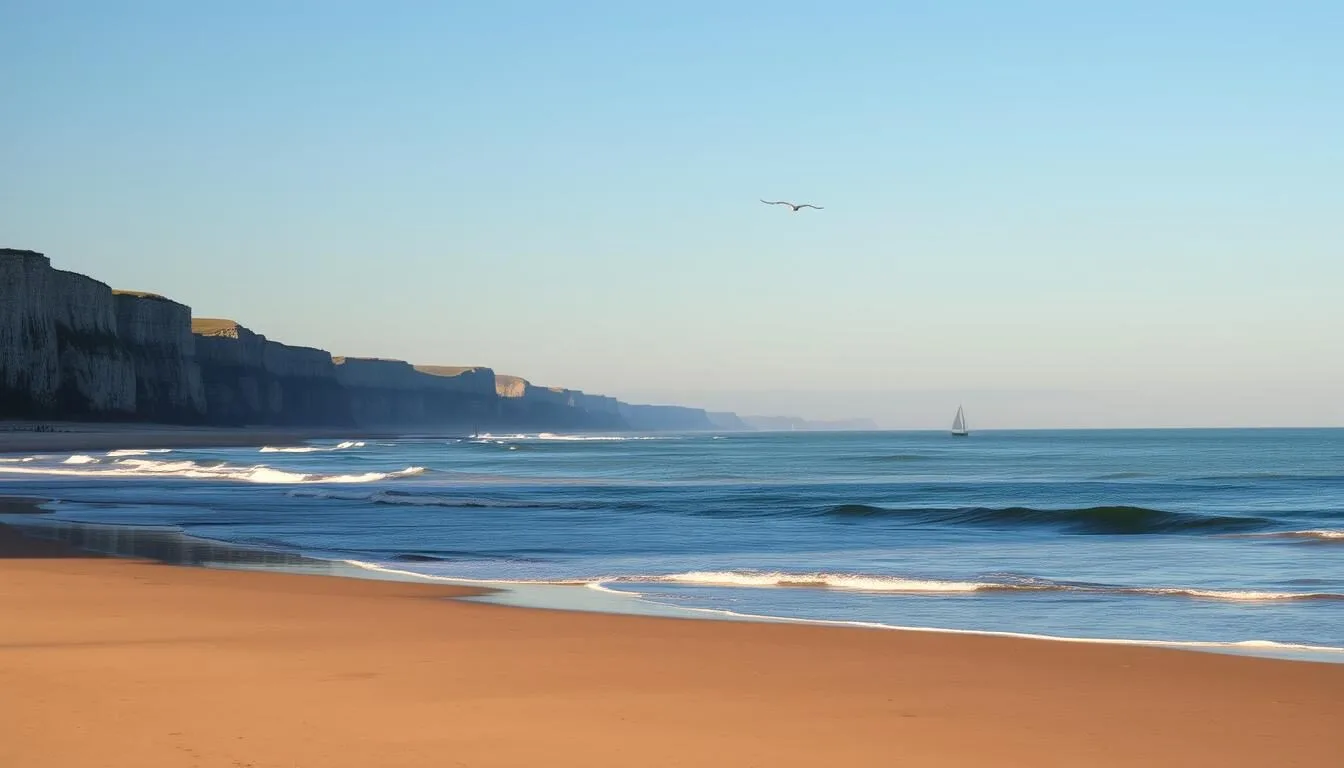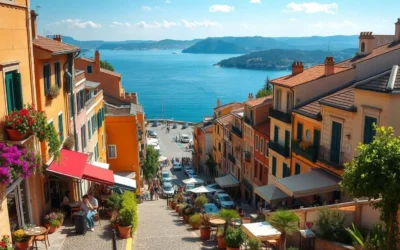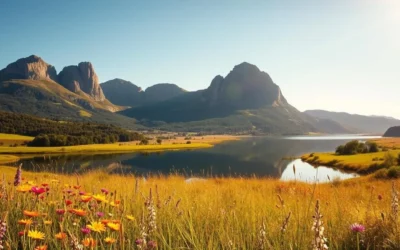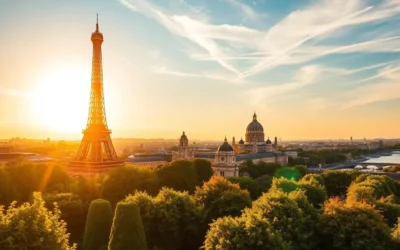Did you know that thousands of Americans fought and lost their lives in World War II’s Battle of Normandy? This historic region in France is not only sacred land but also a treasure trove of captivating experiences and attractions.
Accessible from Paris in just a 1.5-hour train ride, Normandy is an easy destination to explore and fall in love with. As the home to the second most popular tourist destination in France, Mont St. Michel, you’ll find a region rich in history, natural beauty, and culinary delights.
From its stunning beaches and dramatic coastlines to its medieval towns and historic landmarks, Normandy should be on your travel bucket list. Whether you’re interested in history, art, food, or simply soaking in the picturesque landscapes, this region has something for everyone.
Discovering the Charm of Normandy
Normandy, a region in northern France, is a treasure trove of history, natural beauty, and gastronomic delights. With its rich heritage and picturesque landscapes, it’s an ideal destination for a day trip or an extended trip from Paris, the capital city of France.
Why Normandy Should Be on Your Bucket List
Normandy offers a perfect blend of things to see and do, making it one of the best things to experience in region France. You’ll discover countryside dotted with apple orchards and picturesque villages that seem frozen in time. The region’s history is palpable, with numerous historical sites and museums to explore.
How to Get to Normandy from Paris
Getting to Normandy from Paris is straightforward; take the train from Saint-Lazare station to destinations like Rouen, Dieppe, or Bayeux. The journey takes approximately 1.5-2 hours, depending on your destination. Consider hiring a guide for a more in-depth experience, especially if you’re interested in the historical aspects of the region.

Mont Saint-Michel: A Medieval Marvel
The majestic Mont Saint-Michel, a UNESCO World Heritage site, is a must-visit destination in Normandy. This medieval abbey, dating back to the 7th century, is situated on a rocky islet surrounded by the magnificent Mont Saint-Michel Bay.
Exploring the Abbey and Medieval Town
As you explore Mont Saint-Michel, you’ll discover the charm of this medieval town. With about 200 steps leading past souvenir shops and restaurants to the abbey’s entrance, and another 150 stairs inside, you’ll experience the rich history and architecture of this iconic site. Take your time to appreciate the remarkable medieval architecture and the stunning views of the bay from various vantage points.
Mont Saint-Michel is one of the most breathtaking things to see in Normandy, rising dramatically from the sea on a rocky islet. The best time to visit is early morning or late afternoon to avoid the crowds that flock to this site during peak day hours.
Tips for Avoiding Crowds and Best Photo Spots
To make the most of your visit, consider staying overnight on or near Mont Saint-Michel to experience the tranquility after day-trippers have departed. For the best photo spot, walk along the causeway for a classic view, or venture onto the beach at low tide (with a guide) for unique perspectives of this iconic place. Be sure to check the tide schedules before your visit, as the changing water levels create a magical effect around Mont Saint-Michel.
D-Day Beaches and WWII Memorials
As you walk along Normandy’s D-Day beaches, you’re retracing the steps of Allied forces on June 6, 1944. This experience is both somber and enlightening, offering a glimpse into a pivotal moment in history. The beaches, now peaceful, are a testament to the sacrifices made by thousands of soldiers.
Omaha Beach and American Cemetery
Omaha Beach, one of the five landing beaches, holds particular significance for American visitors. The American Cemetery overlooking Omaha Beach contains nearly 10,000 graves of U.S. servicemen, creating a solemn and powerful memorial that honors those who gave their lives for freedom. The Normandy American Cemetery Visitor Center has no admission fee and offers informative exhibits.
Pointe du Hoc and Other Key Sites
Pointe du Hoc, where U.S. Rangers scaled 100-foot cliffs under enemy fire, still bears the scars of battle. Visitors can explore the bomb craters and bunkers, gaining a visceral connection to the events of D-Day. A guided tour of these historic sites can provide valuable context and stories, bringing the events to life.
The museum in Caen provides comprehensive exhibits about the Battle of Normandy, worth visiting before or after touring the beaches. By exploring these sites, you’ll gain a deeper understanding of the significance of D-Day and its impact on life and history.
The Bayeux Tapestry: A Historical Masterpiece
The Bayeux Tapestry is a monumental embroidery that chronicles a pivotal moment in European history. This 230-foot long cloth is an extraordinary 11th-century historical document that depicts the events leading up to William the Conqueror’s victory at the Battle of Hastings in 1066.
Understanding the 11th Century Embroidery
The Bayeux Tapestry is not just a piece of art; it’s a detailed historical narrative. With over 50 scenes and Latin inscriptions, it provides a unique visual account of this significant time in history. When you visit the Bayeux Tapestry Museum, be sure to use the audio guide to fully appreciate the century-old embroidery.
Exploring the Charming Town of Bayeux
Bayeux, the town that houses the tapestry, is a charming village that has preserved its medieval character. It’s an ideal home base for exploring the D-Day beaches and other historic sites. Take your time to wander through the medieval center and visit the magnificent Bayeux Cathedral, which dates back to the times of William the Conqueror.
Honfleur: Normandy’s Most Picturesque Harbor
Honfleur’s old harbor, known as Le Vieux Bassin, is a breathtaking sight that has inspired artists for centuries. As you stroll through this charming destination, you’ll discover a treasure trove of historic landmarks, artistic treasures, and delicious Norman cuisine.
Le Vieux Bassin and Historic Center
The heart of Honfleur is its beautiful Old Harbor, where you can enjoy fresh seafood with rich Norman cream while watching boats gently rock in the port. Take a leisurely walk through the town’s narrow, cobbled streets and explore the remarkable Sainte-Catherine church, the largest wooden church in France with its separate bell tower.
Impressionist Connections and Art Museums
Honfleur is considered the birthplace of Impressionism, and art enthusiasts should make this charming destination a priority on their trip. Visit the Eugène Boudin Museum to learn more about the life and works of this influential artist, and discover the many places that inspired his paintings. With its rich artistic heritage and stunning harbor views, Honfleur is easily accessible by train from Paris, making it a popular day trip or weekend getaway.
Etretat and the Alabaster Coast
Normandy’s Côte d’Albâtre, or Alabaster Coast, is famous for its dramatic white cliffs and natural sea arches. The most well-known section of this coastline is at the small seaside village of Etretat, which sits about 45 minutes northeast of Honfleur.
Dramatic White Cliffs and Sea Arches
Etretat’s dramatic white cliffs and natural sea arches create one of Normandy’s most photographed landscapes, offering breathtaking views that have inspired artists for generations. The Alabaster Coast stretches for 80 miles, featuring stunning chalk cliffs that mirror the White Cliffs of Dover across the English Channel.
Best Viewpoints and Walking Paths
For the best viewpoints of Etretat’s famous arches, take a guided tour along the cliff-top walking paths, where you’ll find perfect photo spots of formations like the Needle (l’Aiguille) and the Elephant. The GR21 coastal path offers spectacular panoramas of the beaches and cliffs, with well-marked trails suitable for various fitness levels.
After your walk, reward yourself with fresh local oysters at one of the seaside restaurants, pairing perfectly with a glass of crisp Norman cider. Visit at different times of day to experience how changing light transforms the landscape – early morning and sunset offer particularly magical views of the white cliffs against the sea.
Rouen: Normandy’s Medieval Capital
Rouen, Normandy’s medieval capital, offers a unique blend of historical landmarks, cultural experiences, and gastronomic delights. As an UNESCO City of Gastronomy, it’s a great place to start sampling Normandy cuisine.
Gothic Cathedral and Historic Center
The magnificent Gothic cathedral, immortalized in Claude Monet’s famous painting series, dominates the town’s skyline and features the highest spire in France. With over 2,000 half-timbered buildings, Rouen’s historic center is a journey through medieval times.
Following the Footsteps of Joan of Arc
One of the most important things to do in Rouen is visit the site where Joan of Arc’s life ended when she was burned at the stake in 1431. The Historical Jeanne d’Arc museum, located in the former archbishop palace behind the cathedral, tells her story and highlights her significance to France.
As you explore Rouen, you’ll encounter the Great Clock (Gros-Horloge), one of the oldest working clock mechanisms in Europe, and wander through pedestrian-friendly streets lined with antique shops and cafés. The Musée des Beaux-Arts houses an impressive collection of Impressionist works, reflecting the region’s significant contribution to art history.
Giverny: Monet’s Garden Paradise
Giverny, a charming village in Normandy, is a must-visit destination for art lovers and nature enthusiasts alike. The village is home to Claude Monet’s famous gardens, which inspired many of his most renowned works, including the water lilies series.
Water Lilies and Japanese Bridge
Monet’s gardens in Giverny are divided into two distinct areas: the flower garden with its famous Grande Allée, and the water garden featuring the iconic Japanese bridge and water lily pond. The water lilies are a major attraction, and the Japanese bridge is a photographer’s delight.
Best Time to Visit and Photography Tips
To make the most of your visit, arrive early in the morning to avoid crowds and capture the garden in the soft morning light. Summer brings the famous water lilies into bloom, though spring and fall offer their own colorful displays. For best results, bring a polarizing filter to reduce glare on the water, and use a wide-angle lens to capture the expansive gardens.
Normandie (Normandy), France: Best Things to Do for Food Lovers
Normandy, France, is a paradise for food lovers, with its distinct cuisine and local specialties. The region’s culinary landscape is characterized by its rich produce, including apples, pears, and cream, which are used to create a variety of delicious dishes and products.
Camembert, Calvados, and Cider: The Three Cs
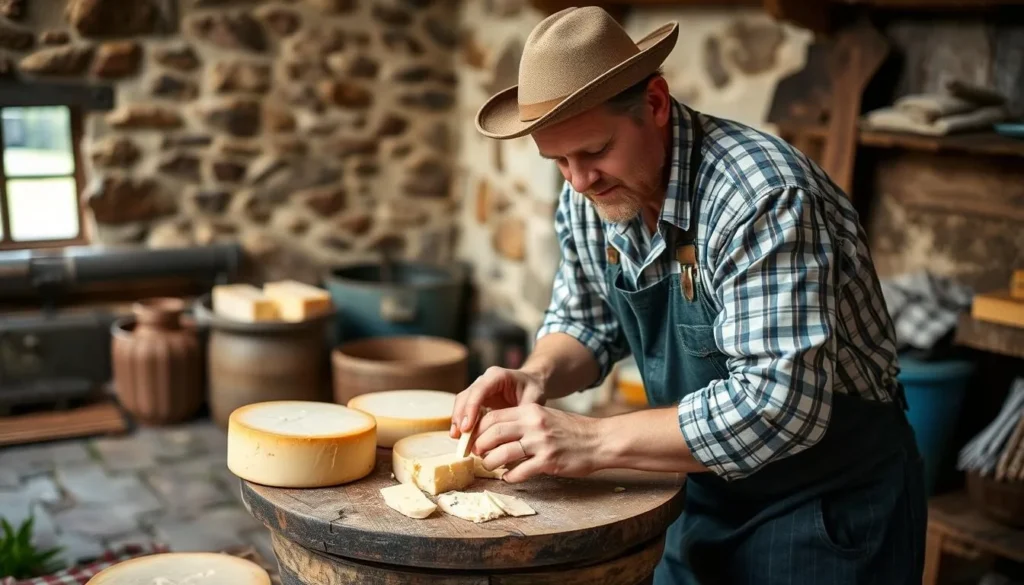
Exploring Normandy’s culinary delights is among the best things to do in the region. The famous “Three Cs” – Camembert cheese, Calvados apple brandy, and Cider – form the cornerstone of Norman gastronomy. Camembert, with its rich, creamy texture and earthy flavor, originated in the Norman village of the same name. Normandy’s apple orchards give life to Calvados, a distinctive apple brandy aged in oak barrels.
Seafood Delights: Oysters and More
The region’s coastal location makes it a paradise for seafood lovers, with fresh oysters from places like Utah Beach and Saint-Vaast-la-Hougue offering an unforgettable taste experience. Don’t miss trying authentic Normandy specialties like teurgoule (cinnamon rice pudding) and marmite dieppoise (seafood stew) for a complete taste of the region. Norman cream, exceptionally rich and flavorful, appears in countless regional specialties, making every day a delicious culinary adventure.
Deauville and Trouville: Seaside Elegance
Deauville and Trouville, twin gems on the Normandy coast, offer a sophisticated seaside escape that’s hard to resist. You can reach these charming towns by a quick train ride from Paris, making them ideal for a weekend trip.
Beach Promenades and Belle Époque Architecture
Stroll along Deauville’s famous promenade, Les Planches, lined with art-deco beach cabins named after Hollywood stars. The pristine beach and elegant Belle Époque architecture create a perfect spot to relax and enjoy the sea views.
Casino Life and Film Festival
Deauville comes alive during the summer with its vibrant atmosphere, and in September, it hosts an international film festival, attracting celebrities to the cliffside red carpet. Whether you visit during summer or another time, Deauville and Trouville maintain their charm with casinos, luxury shopping, and fine dining.
Don’t miss the chance to cross the bridge between Deauville and Trouville to experience their distinct personalities. Deauville is known for its designer boutiques, while Trouville offers a more laid-back atmosphere with its fish market.
Charming Villages of Normandy
The charming villages of Normandy are a treasure trove of traditional French architecture, scenic landscapes, and local cuisine. Exploring these villages is one of the most delightful things to do in the region, offering glimpses into authentic rural French life away from tourist crowds.
Veules-les-Roses and Beuvron-en-Auge
Veules-les-Roses enchants visitors with its combination of seaside charm, France’s shortest river dotted with watermills, and a beautiful beach framed by dramatic white cliffs. Beuvron-en-Auge represents the quintessential Norman village with its half-timbered houses, central square, and surrounding apple orchards that produce some of the region’s finest cider and cream-based products.
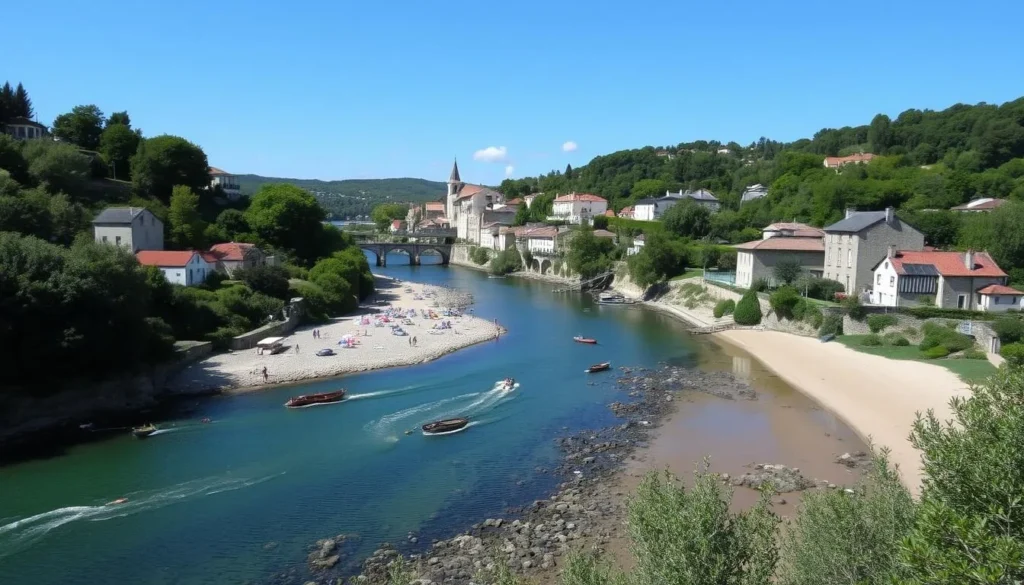
Le Bec-Hellouin and Barfleur
Le Bec-Hellouin, dominated by its magnificent abbey, has been recognized as one of “Les Plus Beaux Villages de France” for its perfectly preserved medieval architecture. Barfleur, a picturesque fishing port on the Cotentin Peninsula, offers visitors fresh oysters direct from the sea and stunning coastal views in a peaceful setting.
These villages provide perfect stopping places while driving through the Norman countryside, allowing you to experience the region’s rural character and traditional architecture.
Viking Heritage in Normandy
As you explore Normandy, you’ll discover that its Viking heritage is an integral part of its story, influencing everything from place names to cultural traditions. The name “Normandy” itself is derived from the “Northmen” or Norsemen who settled in this region of France during the 9th and 10th centuries.
Historical Sites and Museums
Throughout Normandy, you can visit historical sites and museums that showcase its Viking history. The Cité Immersive Viking in Rouen offers an immersive experience into the region’s Viking past, while smaller village museums provide insights into Viking life and culture.
William the Conqueror’s Legacy
William the Conqueror, Duke of Normandy, played a pivotal role in shaping the region’s history, eventually claiming the English throne in 1066. His legacy is still visible in landmarks such as his castle in Caen and his birthplace in Falaise, which offer glimpses into the century that transformed Normandy into a powerful medieval duchy.
Jumièges Abbey and Other Religious Sites
The serene landscapes of Normandy are dotted with ancient religious sites that whisper tales of the past. One of the most enchanting places to visit is Jumièges Abbey, often described as “the most beautiful ruins in France.”
Exploring the “Most Beautiful Ruins in France”
Jumièges Abbey, with its striking white-stone towers and soaring facade, is a highlight of any visit to Normandy. Originally built in the 7th century, this Benedictine monastery has a rich history marked by periods of destruction and rebirth.
Other Notable Abbeys and Churches
Beyond Jumièges, Normandy is home to numerous other significant religious sites, including the Abbey of Mont-Saint-Michel, the Abbey of Bec-Hellouin, and the magnificent cathedral in Bayeux. These sites not only showcase stunning architecture but also house artistic treasures like illuminated manuscripts and stained glass.
Outdoor Activities in Normandy
Normandy’s picturesque countryside and dramatic coastline make it an ideal destination for outdoor activities. The region offers a diverse range of landscapes, from the dramatic cliffs of the Alabaster Coast to the picturesque villages and apple orchards of the countryside.
Hiking the Coastal Paths
The GR21 coastal path is one of France’s most beautiful hiking trails, stretching for 180km along Normandy’s coastline. It offers breathtaking views of beaches and cliffs, as well as the ever-changing waters of the English Channel.
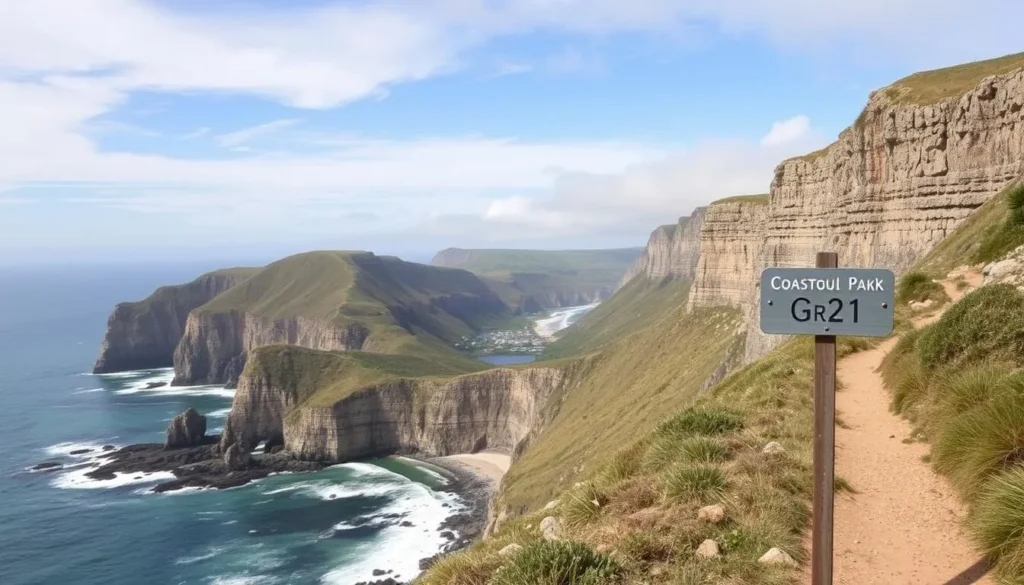
Cycling Through the Countryside
Cycling through the Norman countryside provides a perfect way to experience the region at a relaxed pace. Dedicated bike routes connect charming villages, historic abbeys, and scenic viewpoints, allowing you to take in the beauty of the region.
After a day of outdoor activities, you can reward yourself with fresh local oysters and cider at one of the many coastal restaurants, showcasing the best of region France’s culinary traditions. Many visitors also enjoy following in Claude Monet’s footsteps, capturing the region’s famous light and landscapes through painting or photography.
Planning Your Perfect Normandy Itinerary
Whether you’re a history buff, a foodie, or an adventure seeker, Normandy has something to offer, making it essential to plan your trip carefully.
3-Day, 5-Day, and Week-Long Routes
For a 3-day trip, focus on one region of Normandy, perhaps combining the American Cemetery and D-Day beaches with Bayeux (for the Bayeux Tapestry) and Mont Saint-Michel.
A 5-day itinerary allows you to add coastal highlights like Honfleur and Etretat, plus time to explore inland attractions such as Giverny or a historic abbey.
Week-long routes give you the luxury of deeper exploration, including lesser-visited places and time to enjoy Normandy’s beaches, cuisine, and countryside at a relaxed pace.
Best Time to Visit and Seasonal Highlights
The best time to visit Normandy is May through September for pleasant weather, though each season offers unique attractions – spring for apple blossoms, summer for beach time, autumn for harvest festivals, and winter for fewer tourists.
Consider transportation options carefully – while trains connect major towns, a rental car offers the most flexibility for exploring rural areas and coastal drives.
Conclusion: Why Normandy Captures Hearts
This enchanting region in northern France offers an unforgettable experience, weaving together history, beauty, and flavor. Normandy’s diverse landscapes, from dramatic cliffs to rolling countryside, provide a scenic backdrop for exploring its rich historical tapestry. You can visit the American Cemetery at Omaha Beach, a poignant reminder of the region’s pivotal role in modern history.
Normandy’s culinary traditions are centered around apples, dairy, and seafood, offering a distinctive taste of France. You’ll savor rich cream sauces, camembert cheese, and calvados, creating unforgettable dining experiences. Whether you’re drawn to history, art, or simply enjoying the beauty of the region, Normandy has something for every traveler, making it a beloved destination.
By the time you leave, you’ll understand why Normandy has been inspiring artists, conquerors, and travelers for centuries, making it one of the best things to experience in France.
—
The above is subject to change.
Check back often to TRAVEL.COM for the latest travel tips and deals.
